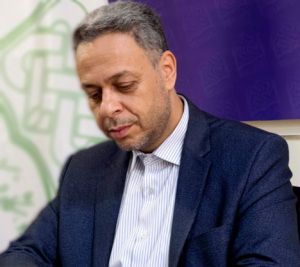TAWBAH WA AHAMMIYYAT ĀN DAR ISLĀM WA SĀYIR ’ADYĀN [REPENTANCE AND ITS IMPORTANCE IN ISLAM AND OTHER RELIGIONS]. By Hossein Ali Ja‘fari. Tehran, Iran: Ḥikmat wa ‘Irfān. 2024. Pp. 214. Paper. 2,400,000 IRR.
Repentance is a well-known term in the culture of Islam and other religions and spiritual doctrines. It encompasses a phenomenon that is considered a distinct characteristic of humanity, absent in other beings. The act of repentance signifies a return from a misguided path towards God. In this context, numerous works have been produced; however, the distinguishing characteristic of this particular piece is its exploration of the concept of repentance within religions.
This work is divided into nine sections. The first section explicates the concept of repentance from the perspective of Iran’s leader, Ayatollāh Seyyed ‘Alī Khāmene’ī. He emphasizes that an individual must seek God’s forgiveness and mercy in order to cleanse the heart from the stains of sin. According to Quranic teachings, this quest for forgiveness brings down the heavenly blessings. The Quran attributes saving Prophet Jonah from the belly of the whale to his repentance. Repentance is obligatory for everyone, including prophets; however, the nature of a prophet’s repentance differs from that of ordinary individuals, as, according to Shia beliefs, prophets do not commit sins. The initial step in repentance involves recognizing one’s own faults. The success of repentance and a return to God is seen as a result of God’s attention towards humanity; When God directs attention to the human heart, the human heart, in turn, becomes inclined towards the Almighty.
 The second section explores the concept of repentance according to Imām Khomeinī. He posits that repentance is the foremost station of mystics and seekers on the path of truth, requiring a renouncement of all that is not God and a complete orientation towards Him. One of the critical prerequisites of repentance is divine grace, described in the Quran as God’s return to humanity. The second prerequisite is an awareness of the dire consequences of sin, as the heart is the dwelling place of God, and sin devastates it, weakening the individual’s relationship with the Divine. Various scholars of Islamic science have articulated diverse perspectives on the essence of repentance. Many scholars identify its essence as remorse and regret, while others view it as a firm resolve to abandon sin. Scholars like Al-Ghazāli, Narāqi, and Faiḍ Kāshāni define repentance as an awareness of the harms of sin, an emotional state of regret regarding past actions, and a determination to cease sinful behaviors. Scholars such as Morteḍa Moṭahharī and Allāmeh Ṭabāṭabā’i interpret repentance as a return to God, a definition adopted by Imām Khomeinī. However, he insists that this return consists of two fundamental components: regret and the resolve to forsake sin, indicating that mere remorse without such resolve does not constitute genuine repentance. Imām Khomeinī outlines that for repentance to be accepted, individuals must restore the rights of others and the rights due to the Creator, though these conditions should be fulfilled to the extent possible for the individual.
The second section explores the concept of repentance according to Imām Khomeinī. He posits that repentance is the foremost station of mystics and seekers on the path of truth, requiring a renouncement of all that is not God and a complete orientation towards Him. One of the critical prerequisites of repentance is divine grace, described in the Quran as God’s return to humanity. The second prerequisite is an awareness of the dire consequences of sin, as the heart is the dwelling place of God, and sin devastates it, weakening the individual’s relationship with the Divine. Various scholars of Islamic science have articulated diverse perspectives on the essence of repentance. Many scholars identify its essence as remorse and regret, while others view it as a firm resolve to abandon sin. Scholars like Al-Ghazāli, Narāqi, and Faiḍ Kāshāni define repentance as an awareness of the harms of sin, an emotional state of regret regarding past actions, and a determination to cease sinful behaviors. Scholars such as Morteḍa Moṭahharī and Allāmeh Ṭabāṭabā’i interpret repentance as a return to God, a definition adopted by Imām Khomeinī. However, he insists that this return consists of two fundamental components: regret and the resolve to forsake sin, indicating that mere remorse without such resolve does not constitute genuine repentance. Imām Khomeinī outlines that for repentance to be accepted, individuals must restore the rights of others and the rights due to the Creator, though these conditions should be fulfilled to the extent possible for the individual.
The third section discusses repentance from the perspective of Imām ‘Alī, the first Shia Imām, as articulated in Nahj al-Balāgha. He defines repentance as entailing: first, remorse for past misdeeds; second, a commitment to abandoning wrongdoing; third, fulfilling the rights of God’s creations; fourth, performing obligatory acts; fifth, Melting the flesh that has grown on the body from the wrath of God; and sixth, experiencing the suffering as intensely as one has tasted the sweetness of sin before exclaiming, “I seek God’s forgiveness.” He also notes that the sins of individuals diminish the descent of rain and divine blessings until the sinner repents.
The fourth section discusses repentance as viewed by Imām Sajjād, the fourth Shia Imam, in Ṣaḥīfa Sajjādīya. One notable prayer in Ṣaḥīfa Sajjādīya discussing repentance is the thirty-first supplication. He describes repentance as an inner, heartfelt regret for sinfulness and an apology to God, asserting that verbal repentance alone is insufficient. He believes that the aim of repentance is purity from sin and readiness to achieve spiritual growth and perfection. In his view, the conditions of sincere repentance include: it must be genuine and irrevocable, fully purging the heart of impurities, repentance should be inclusive in the sense that every member of the body should fulfill their right in repentance, and being a lifelong commitment to forsaking sin.
The fifth section addresses repentance and its place in mysticism. For mystics, repentance represents one of the most critical stations for seekers of the path of truth. Muḥyī al-Dīn Ibn ‘Arabī, a prominent figure in Islamic mysticism, dedicates an extensive chapter to this topic in Futuḥāt al-Makkīyah. In the subjective view of mystics, the initial station in the journey of mysticism is repentance. They outline three levels of repentance: the first is general, i.e., repentance from sins; the second is specific, i.e., repentance from Abandoning the better (tark al-awlā), exemplified in the case of Prophet Adam; and the third is the most specific, which is repentance from attention to anything other than God, just as the Prophet Muḥammad may claim to repent a hundred times a day. Mystics regard the ideal model of repentance as Tawbah Nasuh, which refers to a commitment never to pursue sin again for the duration of one’s life.
 The sixth section involves the analysis and breakdown of the concept of repentance. Repentance has both a general and specific meaning; the general meaning encompasses a return from evils and sins, encompassing a turn from erroneous thoughts and beliefs. Accordingly, Allameh Tabatabai asserts that the Quranic interpretation of repentance refers to the broader meaning, relating to a return from polytheism and infidelity as well as from disobedience. Furthermore, repentance is not merely a verbal act; rather, it represents a spiritual and psychological transformation, with the term Istighfār denoting this internal state, a feature inherently human.
The sixth section involves the analysis and breakdown of the concept of repentance. Repentance has both a general and specific meaning; the general meaning encompasses a return from evils and sins, encompassing a turn from erroneous thoughts and beliefs. Accordingly, Allameh Tabatabai asserts that the Quranic interpretation of repentance refers to the broader meaning, relating to a return from polytheism and infidelity as well as from disobedience. Furthermore, repentance is not merely a verbal act; rather, it represents a spiritual and psychological transformation, with the term Istighfār denoting this internal state, a feature inherently human.
In seventh section, the question is raised regarding how an individual enters the realm of repentance. Is repentance an act of free will, or not? The author asserts that sin contaminates the soul of an individual, and if one is wise, they will consciously distance themselves from sin, thereby creating the conditions necessary for repentance and return. Repentance is an endeavor aimed at eradicating this moral darkness, which can only occur when an individual recognizes this darkness and is prompted to act in order to eliminate it.
The eighth section delves into the concept of repentance within the Quran and Hadith. The term tawba appears eighty-seven times in the Quran. Among the prominent attributes of the faithful outlined in the Quran is being a “Tā’ib” (one who repents). The term Tawwāb meaning ‘one who greatly accepts repentance,’ appears six times in the Quran. The Quran identifies repentance as a manifestation of divine grace bestowed upon the servant, indicating that after the servant’s repentance, the moment arrives for God to repent, which symbolizes God’s attentiveness towards the servant. One noteworthy conclusion drawn from various verses is that repentance is inherently associated with restitution and rectification. According to the sayings of the Ahl al-Bayt, repentance is introduced as a divine tether. It consists of four pillars: remorse in the heart, seeking forgiveness with the tongue, taking actions with the body’s faculties, and deciding to refrain from reverting to past sins. Reports suggest that in certain situations, repentance may not be accepted, such as in cases involving the rights of others. Sins that become widespread and divert people from the path of truth likewise render the related repentance ineffective. Moreover, repentance must occur before facing the afterlife; upon encountering such realms, repentance is no longer accepted. According to the Quranic verses and related Hadith, repentance leads to the forgiveness of sins, rectification of the past, the descent of divine mercy, and favor in God’s eyes. In a narration from the Prophet Muḥammad indicates that nothing is more beloved to God than a man or woman who repents. Imām ‘Alī remarks that abstaining from sin is easier than seeking repentance, and another narration states that seeking forgiveness secures the protection of the inhabitants of the earth from divine punishment.
 In the final section, the author examines repentance across various religions. In Buddhism, the Dharma Shastra and the Vedas advocate for contemplation, repentance, and atonement for sins. In Buddhism, repentance fundamentally consists of acknowledging one’s negative physical and mental actions and repenting toward those whom one has wronged. Such confessions liberate the individual from guilt, allowing a cleansing of the mind. In Hinduism, the term Prayachitta, derived from Sanskrit, refers to atonement or repentance. It involves confessing improper deeds, engaging in austerities, fasting, pilgrimages, and ritual ablutions in sacred waters, leading a life of asceticism, performing sacrifices, praying, practicing yoga, and giving to the needy. Sikh teachings encourage individuals to seek forgiveness from God for their sins, promising absolution for those who listen to the teachings of the Guru and adhere to the tenets of the sacred scripture Guru Granth Sahib. According to Shinto, humans must maintain purity and cleanliness to connect with the Kami (spiritual beings) and have their prayers accepted, achieved through specific acts such as offerings and gifts to shrines. Researchers note that in Shinto, no concept of sin exists; rather, the primary concern is purity and avoiding from impurity, with purification acts substituting for repentance. In Jainism, Pratikramana is a ritual performed by Jains to address wrongful actions, emphasizing penitence, spiritual reflection, and a resolve to abstain from sin. This ritual should be performed at least twice daily to help individuals detach from previously committed karmic actions. In Confucianism, a recently established practice of confession and repentance has emerged. In Taoist temples, monks conduct repentance ceremonies for disciples and worshippers to confess their sins before the deities. Ancient Iranian texts in Zoroastrianism suggest that whenever an individual commits an error, they must perform a socially beneficial act as compensation to free their spirit from the consequences of that sin and the torments of hell. In Zoroastrianism, repentance (Patet) plays a significant role in the forgiveness of both major and minor sins. In Judaism, deliverance hinges on the repentance; a crucial element of repentance is the recognition of God’s grace. It asserts that to repent, one must first confess their sins. In Judaism, the repentance of individuals closely correlates with hastening the arrival of the Promised One. In Christianity, as in other Abrahamic faiths, repentance is fundamental and defines a transformation in one’s thought process leading to remorse and regret over sin, summoning God’s assistance through the Holy Spirit to transcend sin and comply with divine will. According to the Gospel of Luke, the foundation for repentance in Christianity traces back to John the Baptist’s exhortation to his people, while the Acts of the Apostles attributes the initiation of the call to repentance for Christianity to the Apostle Peter.
In the final section, the author examines repentance across various religions. In Buddhism, the Dharma Shastra and the Vedas advocate for contemplation, repentance, and atonement for sins. In Buddhism, repentance fundamentally consists of acknowledging one’s negative physical and mental actions and repenting toward those whom one has wronged. Such confessions liberate the individual from guilt, allowing a cleansing of the mind. In Hinduism, the term Prayachitta, derived from Sanskrit, refers to atonement or repentance. It involves confessing improper deeds, engaging in austerities, fasting, pilgrimages, and ritual ablutions in sacred waters, leading a life of asceticism, performing sacrifices, praying, practicing yoga, and giving to the needy. Sikh teachings encourage individuals to seek forgiveness from God for their sins, promising absolution for those who listen to the teachings of the Guru and adhere to the tenets of the sacred scripture Guru Granth Sahib. According to Shinto, humans must maintain purity and cleanliness to connect with the Kami (spiritual beings) and have their prayers accepted, achieved through specific acts such as offerings and gifts to shrines. Researchers note that in Shinto, no concept of sin exists; rather, the primary concern is purity and avoiding from impurity, with purification acts substituting for repentance. In Jainism, Pratikramana is a ritual performed by Jains to address wrongful actions, emphasizing penitence, spiritual reflection, and a resolve to abstain from sin. This ritual should be performed at least twice daily to help individuals detach from previously committed karmic actions. In Confucianism, a recently established practice of confession and repentance has emerged. In Taoist temples, monks conduct repentance ceremonies for disciples and worshippers to confess their sins before the deities. Ancient Iranian texts in Zoroastrianism suggest that whenever an individual commits an error, they must perform a socially beneficial act as compensation to free their spirit from the consequences of that sin and the torments of hell. In Zoroastrianism, repentance (Patet) plays a significant role in the forgiveness of both major and minor sins. In Judaism, deliverance hinges on the repentance; a crucial element of repentance is the recognition of God’s grace. It asserts that to repent, one must first confess their sins. In Judaism, the repentance of individuals closely correlates with hastening the arrival of the Promised One. In Christianity, as in other Abrahamic faiths, repentance is fundamental and defines a transformation in one’s thought process leading to remorse and regret over sin, summoning God’s assistance through the Holy Spirit to transcend sin and comply with divine will. According to the Gospel of Luke, the foundation for repentance in Christianity traces back to John the Baptist’s exhortation to his people, while the Acts of the Apostles attributes the initiation of the call to repentance for Christianity to the Apostle Peter.
This work provides valuable insights concerning repentance to its audience; however, it lacks appropriate logical structure in the delivery of its content. It would have been more fitting for the sixth section to introduce the concept of repentance at the outset, serving as the initial or introductory facet of the discussion. Furthermore, it would have been appropriate for the fourth and fifth sections, which elucidate the views of Imām ‘Ali and Imām Sajjād—given their revered status among Shia Muslims—to be presented prior to the opinions of Imām Khomeinī Ayatollāh Seyyed ‘Alī Khāmene’ī. Nevertheless, the author could have organized the material in a more coherent manner.
Hossein Baqeri
Tolou International Institute, Qom, Iran
